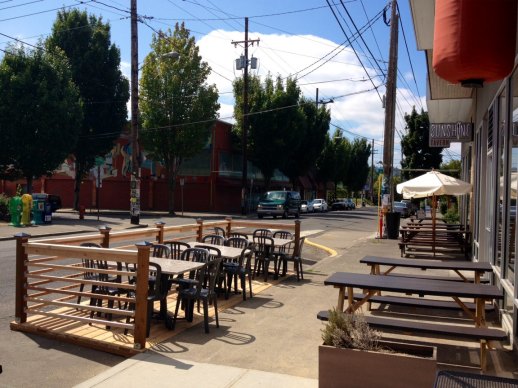
(Photos from anonymous BikePortland reader.)
A reader has sent in a few images of the first “street seats” installation in Portland. The new program was launched last Friday (8/11) to little fanfare by the Bureau of Transportation; but it looks like Japanese ramen joint Wafu got a head start.
Directly in front of their location on SE Division at 31st, Wafu has installed a large wooden deck with three tables and seats for 18 customers in a space of about two on-street auto parking spots. According to head chef Trent Pierce, they finished constructing the deck on Saturday and opened it for business for the evening dinner crowd last night. “It’s awesome,” said Pierce, “It was packed out there last night.”
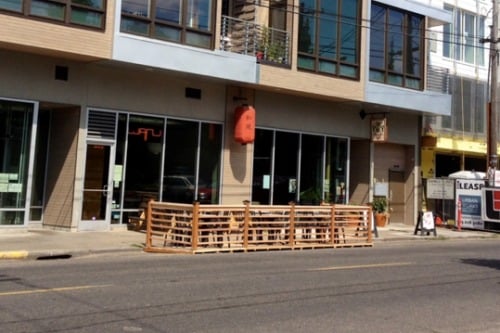
Wafu is a very small restaurant and Pierce said they wanted to expand their summer capacity by having more outdoor seating. They were inspired by parklets in San Francisco and they were planning to approach PBOT about doing one themselves, just as PBOT was coming up with their Street Seats program. Pierce says that PBOT contacted Wafu (and Chef’s Table) owner Kirk Huffman about the idea to see if he wanted to be the test location (contrary to what I reported last week, while PBOT didn’t make any public announcement of the program, they did directly contact several local businesses about the program).
Wafu’s deck is about 6-feet wide and 20-feet long. The seats surrounded with a wooden railing on all three sides. As per PBOT specs, the deck is modular and it can come apart to be moved during winter months. PBOT is only allowing businesses to have street seats for six months out of the year.
Meanwhile, some activists in the community are raising concerns that the new program — by allowing businesses to own these seating areas — privatizes what was formerly public space. Of particular note is how PBOT is calling these “street seats” as opposed to “parklets”. The City does not want people to be confused into thinking these are mini parks for public use. Similar to concerns raised when SW Ankeny was re-imagined to exclude auto traffic, some people feel that PBOT is “privatizing public property for a fee.”
[UPDATE]
PBOT spokesman Dan Anderson says they’re aware of these concerns; but the agency sees this is as a good partnership with business owners. “One of our missions is to be a partner in creating a livable community, and we think programs like this achieve that goal.” Anderson added that, similarly to PBOT’s response when these concerns came up on the SW Ankeny program, they feel there’s a net positive in terms of public space with the program. “I think more members of the public can use this space, than if one person in a car was in it.”
The issue is on the agenda of the City of Portland Pedestrian Advisory Committee, which meets tomorrow in the Pettygrove Room in City Hall from 7:00 to 9:00 pm.
Meanwhile, I’m waiting for a business to replace on-street auto parking with both a bike parking corral and public seating.


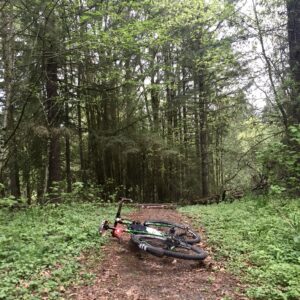
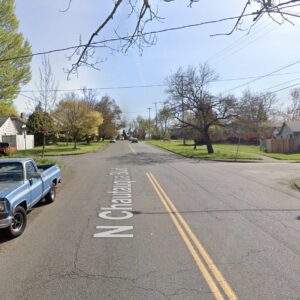
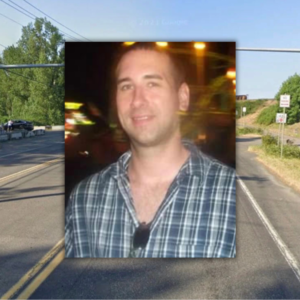
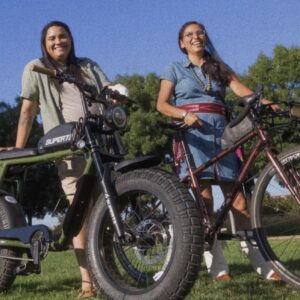
Thanks for reading.
BikePortland has served this community with independent community journalism since 2005. We rely on subscriptions from readers like you to survive. Your financial support is vital in keeping this valuable resource alive and well.
Please subscribe today to strengthen and expand our work.
This is awesome!
I would like a Jersey walls next to me if I was siting next to a lane of traffic.
Interesting that there is nothing protecting customers from cars travelling at 25+ mph. Not quite sure I’d want to sit out there so close to traffic.
Also interesting that a top/down view of that “public space” would show that the restaurant easily has more than 50% of the sidewalk, quite a bit of the street, even the A-frame sign advertising it blocks public right of way on the sidewalk. Perhaps the street seating could be used while clearing off the sidewalk seating for pedestrian throughway access, but right now that is a very business-centric sidewalk…
Still, anything that pulls one parking spot less and encourages pedestrian/bikes is worth supporting. Execution just doesn’t seem quite right…
Wow, I rolled past there yesterday morning on my way to work (~6ish am) and NEVER even noticed it. Maybe I need to drink the coffee on the way to work instead of once I get there. Thankfully, I was not driving…
No offense but who would want to sit alongside cars racing by, the smell of gasoline, the noise, car stereos booming, etc? This seems like such a bizarre idea and one I can’t imagine catching on :/
Geez, Division right there isn’t that bad. That corridor, from about 30th to 36th has pretty slow moving car traffic, in part because of all the great businesses restaurants that are doing solid business. There was faster traffic when there was less business, so I say bring on the front decks.
And on a very related note, Wafu has some really good ramen.
Geez, Division there right sucks… Sitting next to traffic eating over rated food.. You bet:)
Can residential property owners get in on the street seats action? I’d be willing to pay $600 to turn the spots in front of my house into a deck.
I’d get in line for that, too.
Or better yet, how about a bioswale, with bike parking on top/above a grate.
That’s my City of Portland dream. Stormwater management infrastructure that creates usable public space. The current outlay is awesome (bioswale-pedestrain crossing bulb-outs *swoon*), but there’s still so much potential. Let me know if you ever want to work on that together.
Yes – please.
Feel free to send me an email: 9watts at gmail
Fantastic idea!
Yes, fantastic indeed, until the next texting teen on a driver’s permit plows mommy’s SUV into it…ooops! This ain’t Piazza Grande in Verona!
Yeah, I wouldn’t want drivers that close with today’s distracted driver epidemic. Save me a seat next to the building please.
This would be fantastic if they allowed it. When I lived near 34th/Hawthorne I’d have loved to have a few parklets in front of my house instead of my view consisting of people cruising, waiting, and/or fighting over limited curbside space so they could park their cars and walk over to Hawthorne. I certainly didn’t feel entitled to the use of that space simply because it was adjacent to my property and I would have happily paid for that space to help create a more people-friendly pedestrian environment.
This happened in San Francisco.
http://www.deeplet.org
It was probably simpler for Deep to pull this off because he had a curb cut in front of his house, so he wasn’t taking out any parking, because nobody was allowed to park there anyway.
To those complaining about replacing “public” space with “private” space, why do you object to this? They are paying for the space, just like we do when we park our private property there (assuming they have meters). Would you pay more for this space to park your car there?
Some people are willing to fight for their parking subsidies. We need to take this city in a different direction (demand-based parking pricing).
I still think it’s better than giving it away for free private automobile storage like they were doing before…
my thoughts exactly. at least the city is getting some revenue from the space.
Forget free, the city should charge extra on their property taxes for the 6 months out of the year.
The public property in question is currently being used solely for storage of private cars, so I’m not super concerned about it myself. I know that some people see provision of free storage for private vehicles as a legitimate public purpose, but personally I think it is something that the public should at least charge something for. Basically I’m happy to see the space used by people rather than cars, so I’m not really perturbed that the people in question must be purchasing food from Wafu.
And yes, I’d be willing to pay for bike parking once we’re ready for that. I hear people pay a euro or so for all-day bike parking in the Netherlands? A buck or two seems like not such a big deal to me, as long as people have to pay (more) for car parking.
Yeah, I’d be open to that too. You can park 6-8 bikes in a space that accommodates 1 car, so about a buck a day seems right.
Fascinating. In SF, these parklets are still public, which means you don’t have to be patronizing the business to sit there, but it also means regulating the consumption of alcohol is complicated. Tradeoffs tradeoffs.
Regulating the consumption of alcohol is problematic in Oregon, primarily because of the OLCC. Hence the (asinine) ropes around the outdoor seating on Ankeny or being relegated to a cold, dark corner in Director park if you want to enjoy a beer.
I especially love that this is right on a street that is far too fast moving for the pedestrian activity it supports. Hopefully the ‘good neighboors’ driving down Division will realize that going 30 (or higher) in a posted 25mph zone is just plain unsafe on such a narrow street and with so much activity so close by. Or who knows, maybe they’ll speed up to prove the point that they belong on the street and the pedestrians don’t…
And PPB can place one of their mobile ticket vans to correct that flawed logic quickly…
These work for exactly the amount of time they are installed, and little longer.
Better to have the seating in the parking spaces rather than blocking the sidewalk.
And in a surprising twist, PBOT accepts payment for the conversion of an unpaid parking space for an alternate use.
I was thinking these would be limited to the paid (metered) parking spaces. I’m glad to see that we’re not shying away from charging for the use of scarce curbside space even in areas where we continue to subscribe to the outdated philosophy that this scare space should be given away for free to anybody – as long as all they intend to do with it is store their privately owned, state-registered personal vehicle (but don’t try it with your privately-owned personal vehicle if it’s a bicycle).
Hopefully this starts to demonstrate that on-street parking is not “sacred” nor is it a “right,” that businesses do not lose revenue when nearby on-street parking spaces are repurposed from private automobile storage, and that even outside the core there is a value that can be assigned to curbside spaces and that it is foolhardy for the City to pass up this potential revenue stream, especially given the advantages to the City, it’s citizenry, and business community of using market-forces to drive land-use choices and parking rates.
Hi Joseph,
To my knowledge, most business owners experience an uptick in business from parklets due to the increased visibility of their business from the street, the interest that a parklet generates, and from the increased capacity for accommodating customers. The loss of a single parking space – for one person who may or may not be in the neighborhood to patronize that business – seems to have an impreceptible effect on business.
That feedback – that the parklets have a net benefit for business – comes from NYC where the parklet is deemed public property and not reserved for private use. (Disclaimer – That feedback is also based on an unscientific survey consisting of several phone conversations I had last year with a few NYC parklet owners, so take it FWIW)
The public vs. private space conversation is entirely worth having, and the more voices in the conversation, the better.
My personal feeling is that right now we’re using public space for private property storage anyways, and you’re restricted from being in that space unless you’re parking your car there. On-street parking spaces are currently not places where I can sit down to enjoy my lunch anyways. With parklets, the City is able to collect a fee for the private usage that we currently give away for free – and these fees (like parking revenues) can be used for other projects that improve our streets and sidewalks.
Hi Rebecca,
Hopefully I wasn’t coming across as being against this program or being in any way sarcastic or satirical in my comment. Your stated personal opinion on the matter is entirely congruent with my own, with maybe the slight twist that I’d like to see the taxpayers demand payment of a market-driven rate for use of all curbside space.
Actually, I think we’re both on the same page, same paragraph. Just wanted to throw out some background information on the business side 🙂
The key point I’m very confused about is whether these are privatized spaces or not. You write, “The City does not want people to be confused into thinking these are mini parks for public use.” Do you have a source for that? If you look at the application for this program, the application clearly describes these areas as extensions of the sidewalk. The sidewalk is public space, so logically I would conclude that any extension of the sidewalk is also public space. Your reporting seems to indicate that this isn’t true.
However, the application also contains a provision that allows property owners to apply for an outdoor cafe seating permit, which is a separate permit not rolled into the permit for “street seats.” All such outdoor cafe permits are encroachments on public space and as such have to be approved by PBOT depending upon situational conditions — like, will this encroachment still allow enough sidewalk for people who use mobility aids to pass through/by the area? If an outdoor cafe seating permit is granted, that space becomes privatized, reserved for the exclusive use of the property owner. So another question that raises for me is whether it is clear when these “street seats” are actually sidewalk cafes (private) and when they are sidewalk extensions (which I think means public, or should mean public anyway).
Just from looking at the photos of Wafu’s street seats, it seems impossible to tell whether or not Wafu has a cafe permit for this space. Maybe it is posted somewhere. It also looks like people sitting in the chairs that abut the sidewalk are going to end up sticking out into the sidewalk and impeding the right-of-way. But it’s hard to tell — maybe the sidewalk is wider than it looks in the photo.
I’d help you agitate to get Pambiche and other similar places to allow sufficient space on the sidewalk for pedestrians! BTW, I’m just using Pambiche as an example – it’s been a year since I last ate there/walked that stretch of sidewalk so they may have improved things since then.
Actually, Pambiche *did* replace their sidewalk tables within the last year. Gone are the wooden tables that could seat 6, and the new metal tables can only seat four. The sidewalk is wider, and there are signs up in to languages telling customers to keep the sidewalk clear.
I have zero issues with Pambiche’s current use of the space. I would love to see more businesses successfully use their sidewalk as well as Pambiche.
Well, that’s lovely! I’m glad they’ve improved things for pedestrians in front of their restaurant.
Hi Michael,
The concerns about infringement upon the passable pedestrian right-of-way are certainly important. Current cafe seating encroachments are a constant impediment for people requiring mobility devices, parents pushing strollers, and couples who would like to walk side-by-side down a sidewalk together (all of which are important to mobility and quality of life).
How would you feel if a parklet cafe permit were accompanied by a requirement that existing sidewalk furniture be moved to the parklet, thus keeping the entire sidewalk area free for pedestrian passage? That way the parklet would also perform a valuable service for the neighborhood as well as providing business space for the owner.
That’s the only way this should be happening!
How about if the City sent a notice (in a year or so, once this program’s kinks are ironed out) to all businesses which currently obstruct the sidewalk excessively saying, “Hey, you need to stop obstructing the sidewalk so much. If you want to keep the same seating, here’s a program that lets you do so, by using what’s currently free parking! If not, please remove enough stuff so that all pedestrians can get by easily.”
Rebecca, that would depend upon where the “street seats” are located. In the Central City region (which incorporates the Lloyd Center area), the city imposes onerous rules on where people can sit or lie, basically restricting it to the outer limits of the sidewalk, near the curb. PBOT at one point drew up a brochure that explained the area of the sidewalk reserved for pedestrian movement vs. the area where you’re permitted to sit. It was pretty cumbersome (mainly because the ordinance itself, called the Sidewalk Management Ordinance is pretty cumbersome) and in a lot of places you’d almost need to walk around with a tape measure to figure it out. Even moving the existing street furniture to the parklet wouldn’t change this, because no one would be able to sit in the area where existing street furniture is placed. Basically, you can’t sit up against a building, in an area where you might find shelter from the rain. You have to sit out next to the curb.
Outside the Central City, though, where the Sidewalk Management Ordinance doesn’t apply, moving existing street furniture to the parklets might help. The thing is that enforcement of the A-board and sidewalk cafe rules is very lax. The police don’t enforce it, it’s all complaint-driven. And even when a complaint comes in, they just send a letter telling the owner they have to comply but they don’t do anything to ensure compliance. They just wait to see if there are more complaints. You have to be really dogged about it for the rules to be enforced. That’s in marked contrast to the Sidewalk Management Ordinance, which is enforced quite actively by PPB and private security. Last month there were over 60 warnings issued, a significant percentage to people with no address. It’s basically an updated version of ugly laws.
why would anyone want to sit 4′ from cars going by at 20-30mph without some sort of better protection?
Yeah, that’s a little scary. If you sit on the downstream side of the deck (furthest east), you are probably fairly safe.
Chicken and egg…
If you want to slow cars down, you massage the streetscape to encourage people to drive slower. You can do that all sorts of ways, including creating the visual impression of “narrowing” the street. By consuming curbside space with some sort of structure you give the visual impression of narrowing the roadway, similar to curb-cuts, and even though you haven’t taken away any space from the actual travel lanes it does have the affect of encouraging people driving cars to drive slower than they would if the roadway were open from curb to curb.
As you slow traffic down, the street becomes more pleasant for people who aren’t in their cars, and the street seats become safe, charming, and desirable.
But part of that is slowing cars down, and part of that is narrowing the streetscape, which Street Seats will accomplish.
I don’t know if you’re really that much safer on “traditional” outdoor seating that occupies sidewalks right next to the restaurant. A car going fast enough to damage one of these parklets could skip up over a curb and smash into the business.
Though I guess without a parklet there would instead be a 2 ton car sitting there to absorb the impact first. 🙂
I encountered this type of use in Antwerp about a decade ago. I thought it was great then and there, and I think it’s great here and now!
If diners aren’t responsible enough to wear helmets, they can’t really complain if they get hit by a car.
At least not until the dining community shows that it can police itself.
Labels can have unintended consequences. “People with noodles” reflects the temporary status of those who might be lumped into a statistical group by the term “diners”. For example: “The helmeted diners showed good sense of safety and place in the not-to-be-confused-with-a-parklet ‘Street Seats.'” As opposed to: “The people operating noodles, while unprotected by helmets, were clearly poised to spring from harm’s way, due in part to their cleverness and in part to their superior diet.”
Am I the only one curious why the City permitted this installation along a roadway due for a complete rebuild later this fall? http://www.portlandoregon.gov/transportation/41107
Read the article. The patio is temporary; designed to be removed during the winter months.
I’d like to see strong steel poles, rather than the wooden ones holding up that fencing, and close enough together to prevent entry by a car.
And now you’ve made it too expensive to be practical.
What I hear you saying is you want one of these – http://en.wikipedia.org/wiki/Jersey_barrier
It’s only a matter of time till a drunk driver plows a dozen diners. The current implementation seems somewhat reckless.
So we shouldn’t make better use of certain public spaces because the risk of somebody doing something that they shouldn’t be doing might endanger people using that space?
Let’s apply this to other scenarios.
We shouldn’t allow people to congregate at bus stops because it’s only a matter of time before a drunk driver plows through a crowded bus stop.
We shouldn’t allow people to sit within X feet of the street- or parking lot-facing wall of restaurants, because its only a matter of time before some octogenarian mistakes the accelerator for the brake pedal and plows through the wall and into a dozen diners.
We shouldn’t allow people to wait in lines inside banks, because it’s only a matter of time before a robber shows up and guns down a bunch of bank customers.
Hey, you can’t be too safe, right?
What is interesting to me about the number of responses here focused on the probabilities of injury to seated patrons of this restaurant from what I’d be tempted to call reckless driving, but the police would probably identify as improper lane usage, is how overwhelming the threat of violence from cars and their drivers is perceived to be.
And yet our laws do nothing to properly reflect this perception.
When all your lawmakers drive cars, I guess you just can’t expect them to draft legislation that would punish anybody too severely for doing things they know they do behind the wheel when they’re driving.
Not paying attention to what they’re doing, for example. If you’re not paying attention and something bad happens, well that’s just a terrible accident where nobody is at fault, not a conscious decision to callously endanger other people, which is exactly what it is, which, by its very definition, should be treated as criminal negligence.
Exactly. In many European countries, where you might have seating like this drivers would have dire legal consequences for plowing into people — and the drivers KNOW it. In the USA this is not the case, and people get away with homicide all the time.
Can a brotha’ get a cement barrier / cement planter in front / to the side of these things. They look very nice, but distracted drivers on narrow streets (Division = very narrow) is a bad combination.
My son got knocked off his vespa right near there by an auto driver randomly wandering lanes. Totalled the Vespa. Yes he had a helmet, by law.
I Will Not Sit On The Street.
Did you read Joseph’s comment above?
“If you want to slow cars down, you massage the streetscape to encourage people to drive slower.”
This is a dynamic situation. You paint a colorful picture in the middle of an intersection, or plunk cafe seating in a parking space and drivers take note, go slower, no longer are given the impression that they are on a neighborhood version of I-5.
In theory.
Do you have evidence to the contrary? Because there is more than just “theoretical” evidence to support claims about narrower streets slowing down traffic.
Joseph,
Your logic is fundamentally flawed. Streets are narrowed with curbs, bulbouts and planter strips, not living human bodies. Same goes fory your earlier post. All of the “scenarios” you laid out; the bus stop, the restaurant and bank interiors describe spaces meant for people, not autos. I agree that the risk of this use of the street seems high. Putting people in harms way for the sake of taking one or two cars off the street is a poor way to exercise the moral superiority of the anti-car crowd. Those wood rails would do nothing to stop a car traveling the speed limit, let alone faster. Seating ones family at one of these tables would be a reckless act with potentially tragic consequences. Here’s a thought: restrict this use of parking spaces to places protected by bulb outs and bollards directly “upstream” in the direction of oncoming traffic. Then it becomes safe enough to place otherwise unprotected people in the road.
Dude,
people sitting on this deck are not guard rails made of flesh, any more than a pedestrian crossing the street is.
Really? While sitting on that deck slurping up your noodles, how often are you going look both ways for oncoming traffic, AND be able to jump out of the way if and when you see a car coming straight at you, your spouse and/or kids? And will you be able to get them safely out of the way, also?
You are so giddy with the idea of eliminating a couple of parking spaces that you are willing to disregard obvious safety concerns. You are the reckless one.
All spaces are meant for “people.” A “parking space” is intended for automobile storage, so, yes, it is meant for people in cars, but also for people transitioning from driving a car to being a pedestrian on the street. At any given time there may be “people” in any “parking space” but not in a car, so it is not only a space for people in cars, such as a lane of travel on the interstate. It is not a leap to think that you could instead allocate that space for people parking bikes, or people parking their cans on chairs to eat some food and have a beer.
If you’re in a car it just means that you have more responsibility for your actions because what you’re doing is inherently dangerous to those around you. It doesn’t mean that we just shrug our shoulders and forsake opportunities to improve our neighborhoods merely to accommodate the fact that some people don’t yet take their responsibilities while driving seriously enough.
We can’t ignore that these people are out there, but we need to address it with a combination of education and serious enforcement. As people get punished harshly – or see it happen to people they know – they will adjust their behavior, or they will lose their licenses. Well, when we get serious about enforcement and punishment, that is.
I agree with all of that. We just need to make sure all of the risks are considered carefully and appropriate standards for safety are built into the site selection and develpment process. No one wants to see people badly injured or killed because there was nothing more than a wood fence between them and the car that veers a few feet off course because the driver was texting while doing 30 mph down Division. You cannot deny that is a plausible scenario, which means it is only a matter of time.
Waiting for “punishment” to teach people how to behave, in this example, means one or probably more innocent people must be killed or maimed. That’s not acceptable, its avoidable.
“Waiting for ‘punishment’ to teach people how to behave…”
I don’t think we’re talking about the same installation. This is not intended to ‘teach people how to behave.’ Just because some of us suggested – in response to comments that this was sooo dangerous – that there are many ways to calm traffic, doesn’t mean as you seem to think that the diners on the deck are minesweepers.
Yes, as 9watts has said, I’m not suggesting we need to put meaty, living speed bumps between a lane of travel and the sidewalk. I am saying that we need to take steps to move in the right direction and we should not allow ourselves to be so distracted by our culture’s propensity for automobile apologism that we refuse to take simple measures to improve our neighborhoods.
We don’t need to needlessly endanger living things in the process, but we shouldn’t be so quick to rule out good things just because someday somebody might do something illegal and dangerous nearby.
Sweet!
I can think of so many locations that could benefit from this treatment.
Dragonfly Coffeehouse on NW Thurman for starters. Although, they already have a sweet bike coral outside their premises. Time to turn the adjacent spot around the corner into some sweet outdoor seating! (No, really. The sidewalk outside their business is about one foot wide, after the trees & tables & chairs & dogs lying across the path have been taken into consideration…).
Regarding the “private vs. public” thing, it occurs to me that a public installation becomes one more liability (maintenance, use, legal) for the city, while a privatized one gets tended by the one invested in it. Didn’t see that mentioned on this thread yet, pardon me if it was.
I generally like the idea of these street decks.
Design-wise, this particular street deck shown in the picture illustrating this story looks as though it has no provision for water to flow along the curb during rain storms. Sometimes that area of the street has to move a huge amount of water. If something isn’t done about it, this street seat and maybe the street itself, could experience a localized flood.
For all the superfluous public process we go through in this city, I am really shocked that this policy got a pass. This is something that could really benefit from a public discourse about how to make it work.
Sure, the big picture looks good – we’re moving forward with better use of our streets – but it really needs to be done right. I agree that Street Seats are an improved use over car storage, but the fundamental sale of public space still irks me. Who’s the king at PBOT that decided to sell off a public [that is, mutually owned] resource? Without public process, this may need a legal challenge to set truly fair parameters for all – which I believe includes access without patronage.
And yes, the safety factor is ludicrous. Distracted driving is the new drunk driving – take a look around, it’s unbelievably common. We do need to accept some risk in life, but I think it’s irresponsible for the city to suggest this is a safe scenario on streets like Division.
I agree that tons of parklets everywhere, open for all to use, would be better than this. But all that beautiful street furniture doesn’t fall fully-formed from the sky and get maintained by angels. It costs money. If we have to let businesses have control over the street furniture in front of their locations so we can have parking spaces converted to seating *now* rather than in ten years or whenever the City will be flush with money, I’m all for it.
It is not the sale of public space, it is the rental of public space, and I think there is a significant difference between the two. Fundamentally, this isn’t any different than sidewalk cafes. Sidewalks are public space. Businesses get permits to use the public space, and must adhere to the rules.
As for safety, if you don’t want to sit there, don’t sit there. I am happy to sit there with the extremely small chance of vehicular catastrophe.
I’d seen this in San Francisco last few visits. Really great idea, works well, and encourages a lot of positives. Especially on some of San Francisco’s skinnier streets.
I hope to see these start popping up regularly. As stated earlier, nice to see a car spot removed for a spot focusing more on human beings vs big metal things eating up huge amounts of space.